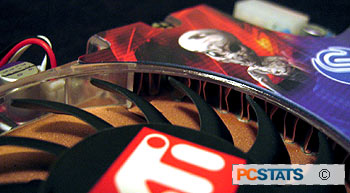The flagship of ATI's expansive product lineup is called
RADEON 9800 XT, a derivative of the original R300 with a few notable additions.
To begin, it features a new VPU, or video processing unit, internally referred
to as R360. Architecturally, it closely resembles the R350, manufactured on a
0.15-micron process and featuring 115 million transistors. The RADEON 9800 XT
core runs 32MHz faster than its predecessor, for a total of 412MHz.
Further, onboard memory has jumped from 128MB to 256MB,
effectively running at 730MHz and capable of delivering up to 23.3GB per second
of bandwidth over the card's 256-bit memory bus.
 Even though the 9800 XT's improvements seem conservative, the core and
memory together dissipate more heat than the old cooling solution could handle. Therefore, ATI
implemented a heatsink and fan combination built entirely of copper.
Even though the 9800 XT's improvements seem conservative, the core and
memory together dissipate more heat than the old cooling solution could handle. Therefore, ATI
implemented a heatsink and fan combination built entirely of copper.
The top of the card sports a copper plate, covered
with rolled copper fins, and topped by a plastic cover that
serves as ducting. Meanwhile, the bottom features another slab of
copper intended to absorb heat from memory modules mounted back there. Compared to
previous cooling solutions from ATI, this one is beefy, but isn't intrusive. The
RADEON 9800 XT continues to occupy a single slot, and while
the included fan is bigger than ever, it is rigged to
run dynamically. That is, an onboard thermocouple actively determines the core's temperature and adjusts
fan speed accordingly. It's hardly audible in a 2D environment.
The obvious reason
for an integrated thermocouple is to monitor onboard temperatures. However, an interesting side
effect is that the card knows when it is running either cooly or entirely too
fast.
Thus, beginning with
the CATALYST 3.8 driver set, ATI includes a software feature called
OVERDRIVE that serves as a form of sanctioned overclocking. For as long as
the RADEON 9800 XT operates within a given thermal range, it will run at higher
frequencies.
For example, at 50 degrees Celsius, OVERDRIVE sets the card
to its maximum setting, 432MHz. As the card heats up, its core frequency
drops to 419MHz, and finally in an extreme case, back to the stock setting of
412MHz.
Overclocking the Sapphire
Just because OVERDRIVE is able to dynamically overclock the 9800 XT doesn't mean it is the most
effective tool for the job. In fact, given the results of our own overclocking tests,
OVERDRIVE seems relatively ineffective at reaching really good speeds.
If you'd like to experiment with a slightly more aggressive utility, Sapphire
bundles its own Redline software, based on Rage3D Tweak. With it, we were
able to hit some incredible speeds, though in order to ensure stability, we
settled on 471MHz for the core and an effective memory clock of 808MHz.
At those enhanced frequencies, the Sapphire 9800 XT demonstrates a roughly 10 percent improvement
in 3DMark03 (cough, cough), jumping from 6466 3DMarks to 7085. The Unreal
Tournament 2003 'Flyby' demo picked up closer 12 percent, and the 'Botmatch'
demo gained three percent, both at 1600x1200.
